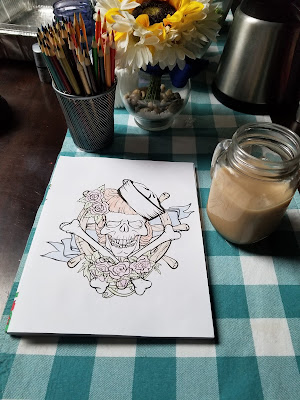Fun Fact Friday: The Winchester Mystery House
If you’ve
been watching TV lately, you’ve no doubt seen the trailer for the recently
released film Winchester: The House that
Ghosts Built. If you’re an avid fan
of horror or the paranormal, you’re familiar with the legend. Here’s the gist: rich widow builds a crazy
mansion to appease the spirits that haunt her.
Building this mansion is a continuous project that lasts 38 years. In honor of the movie’s release last week,
we’re going to delve a little deeper into the fascinating story of a bizarre
home and the woman responsible for its design.
 |
| Sarah Pardee Winchester |
Sarah Pardee was born and raised in Connecticut. In her twenties she married William Wirt Winchester, the only son of firearms magnate Oliver Winchester. They had one child- a daughter- who tragically died at 40 days old due to severe malnutrition because of an inability to process protein. They had no other children. Oliver died in 1880, leaving William as heir to the Winchester Repeating Arms Company. A year later, William died of tuberculosis, leaving Sarah to inherit $20 million and 50% of the company stock. She lived in Europe for a few years, but there is no record of where exactly she went or what she did while she was there. In 1884, she moved to California and purchased an 8-room farmhouse on 161 acres of land in what is now San Jose.
Sarah
Winchester began planning renovations on the house, and hired 20 carpenters to
work 24/7. She was the only architect
and plans for construction came solely from her. The renovations were an
enormous undertaking, and building did not cease until her death in 1922. At one point the massive home had over 500
rooms and was seven stories high before an earthquake in 1906 took down three
floors, leading Sarah to decide to keep it to four stories. It is said that she couldn’t even identify
which rooms belonged to the original farmhouse.
 |
| Aerial View of the Winchester House |
Some of the things in this house are totally expected for a rich old lady's mansion in the late 1880s-early 1900s, such as:
 |
Sewing Room
Beautiful Victorian Bedrom
|
 |
| Opulent Grand Ballroom |
... AND THEN THERE'S THIS SHIT....
 |
| Watch your step when opening this door from the inside... this is a sheer two story drop. |
 |
| Skylight built into the floor |
 |
| Willy Wonka called... He wants his doors back. |
 |
| This tiny little door opens to a staircase built for leprechauns... |
 |
and these stair go... straight to the ceiling???
WTF?!?!?!?
|
The home is filled with architectural oddities, such as stairs that go
right to the ceiling, a door that leads to a sheer two-story drop on the
exterior of the home, and skylights built into the floor. There are hallways with dead ends, large
doors that lead to tiny spaces, and tiny doors that lead to massive rooms
(basically it sounds like a rip-off of Willy Wonka’s factory, minus the candy
and Oompa Loompas). The numbers 7, 11,
and 13 can be found all over the place, as can windows with spiderweb panes.
Now here’s
where it gets tricky. There are different stories about WHY she built this home
and WHY it wasn’t finished until she died in 1922. The most popular story is that, devastated by
the loss of her family, Sarah sought out a Boston medium (spiritualism was a
huge deal at the time). This guy told
her that the spirits of the victims of violence committed with her family’s
rifles were out to get her. In order to
appease them, she needed to build them a space of their own within her home. He
also told her to keep the place in a constant state of renovation, so as to
confuse them into not following her.
The other
theory is that her motive for the constant construction was pure
philanthropy. She was well known as an
altruistic woman, who was involved with various charities. Some historians believe that she kept
renovating the home until she died so that the people in her employ could STAY
employed to support themselves and their families. In fact after her death, she left much of
what remained, not only to several charitable organizations, but also to those
who were her faithful employees for years.
So, was
Sarah Winchester a woman haunted by the victims of violence brought about by
her family’s guns? A do-gooder who
simply wanted to make sure people continued to be employed? Did she simply feel
guilty, and as such, gave what she considered “blood money” back to the people?
We’ll probably never know. However, it
is undeniable that the vast (albeit, bizarre) manse she left behind is an
architectural wonder worthy of a spot on anyone’s travel bucket list.
Until next time, friends!
Until next time, friends!






Comments
Post a Comment